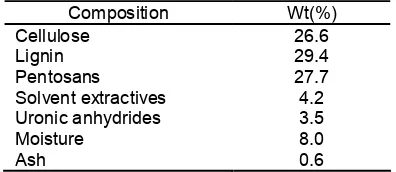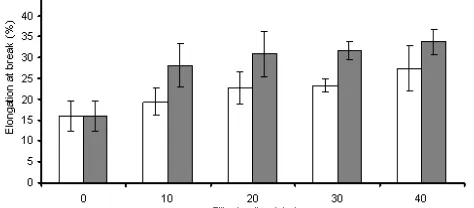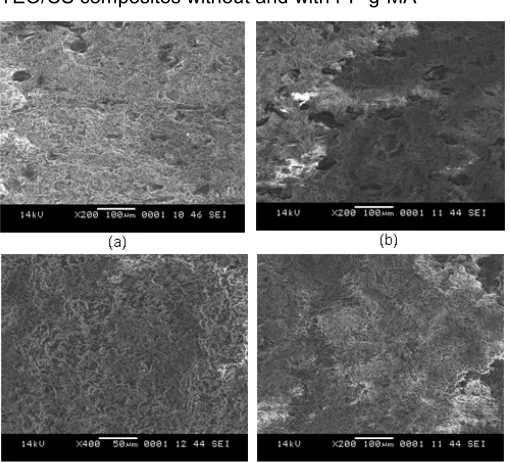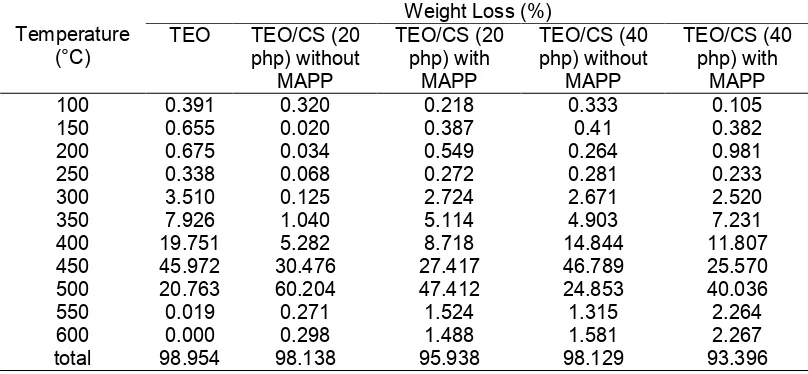EFFECT OF MALEIC ANHYDRIDE POLYPROPYLENE ON THE PROPERTIES OF COCONUT
SHELL FILLED THERMOPLASTIC ELASTOMERIC OLEFIN COMPOSITES
Z.H. Tengku Faisal
1.*, Faisal Amri
2, and Iqmal Tahir
31
Faculty of Engineering, Medan Area University, Medan, Indonesia 20233
2
School of Material Engineering, University Malaysia Perlis, 02600 Jejawi Perlis Malaysia
3
Department of Chemistry, Faculty of Mathematics and Natural Sciences, Universitas Gadjah Mada, Yogyakarta Indonesia 55281
Received June 2, 2010; Accepted July 1, 2010
ABSTRACT
Coconut shell (CS) is one of agro-waste material which has high natural lignocellulosics content. This material provides a potential resource as a reinforcement agent in thermoplastic elastomeric olefin (TEO). In this study, CS was used as filler in TEO composites. The effect of CS loading and Maleic Anhydride Polypropylene (MAPP) as compatibilizer on mechanical properties, morphology and thermal properties were studied. Results show that the increasing of CS loading has increased the tensile strength, elongation at break and Young’s modulus of TEO/CS composites. At similar content, the effect of PP-g-MA as compatibilizer has improved the tensile strength, elongation at break and Young’s modulus of TEO/CS composites. The SEM study of the tensile fracture surface of compatibilized composites indicates that the presence of PP-g-MA increased the interfacial interaction. TGA results show that the composites with addition of MAPP as a compatibilizer has better the thermal stability compared to composites without addition of MAPP at 600 °C. DSC analysis showed that the addition of MAPP decreases the crystallinity of TEO/CS composites. It was found that the presence of MAPP will extended the molecular chain of the TEO/CS composites.
Keywords:thermoplastic olefin, coconut shell, compatibilizer, composites
INTRODUCTION
In the past decade, natural plant materials in the form of fiber and/or particulate have been generally used as reinforcing fillers in polymer composites materials. These naturally occurring fillers are of interest since the production of composites using them inexpensive and their use can reduce environmental problems caused by the use of artificial fillers. Natural plant materials from agricultural residues and forest products’ processing mainly consist of natural lignocellulosic polymers. As a result, they are subjected to thermal degradation during composite processing [1-2]. The advantages of natural plant fibres over traditional glass fibres are acceptable as good specific strengths and modulus, economical viability, low density, reduced tool wear, enhanced energy recovery, and good biodegradability [3].
Coconut shell is one of agricultural waste produced in coastal and tropical countries, made up of “stone cells” and are hard, porous, impregnated with lignins and tannin and a little uronic anhydrides. Many previous researchs primarily motivate by the properties of coconut shell that have high strength and modulus, easy to manufacture and results in considerable value addition. Coconut shell is mainly used as filler in the manufacture of thermoset moulding powder such as phenol
formaldehyde moulding powder and it is a potential candidate for the development of new composites.
Thermoplastic elastomer is block copolymers of an amorphous rubbery block and hard-crystalline juctions. They exhibits an extraordinary combination of reprocessability, elasticity, toughness, low temperature, exibility and strength at relatively high temperature that make them ideal candidates for engineering applications requiring excellent flex fatigue and broad service temperature range. This set of properties is mainly due to the existence of temporary crosslinks tying the chains in an infinite network [4]. Commonly, inorganic fillers are added in TEO formulations to increase their stiffness, improve their dimensional stability, and lower the cost of the compounds. TEO find wide application in automotive parts, extruded profile for windows, cable insulation, footwear, packaging industry etc.
are low degree of dispersion and poor interfacial adhesion between the hydrophilic bio-filler and the hydrophobic matrix polymer [6-8]. To enhance interfacial adhesion between the bio-filler and matrix polymer, many studies have been conducted by various treatment methods like filler surface treatment, using compatibilizer agents or physical pre-treatment. In order to improve the interfacial adhesion between filler and matrix, MAPP have been widely used as compatibilizing agents through the dry blending composites process.
Thermal analysis (TA) means analytical experimental techniques which measure the thermal behavior of a composites material as a function of temperature. The manufacturing temperature and variety of applications in industry of composites are influenced by the thermal characteristics of the coconut shell particles and TEO polymer in this study. Therefore, the thermal properties of TEO/CS composites were studied by using a thermal analyzer. Thermogravimetric (TG) analysis can measure the moisture content, thermal breakdown and thermal stability of TEO/CS materials. Differential Scanning Calorimetry (DSC) is the simplest and most widely used TG technique. Therefore, DSC can be used to measure the melting temperature (Tm) of TEO/CS composites.
The purpose of this research was to investigate the effect of CS loading and MAPP as compatibilizer on mechanical properties, morphology and thermal properties of TEO/CS composites. The thermal decomposition and thermal stability of TEO/CS composites was examined using TGA. The melting temperature (Tm) and enthalpy (ΔHf com) of the TEO/CS composites were examined by DSC.
EXPERIMENTAL SECTION
Materials
Thermoplastic Elastomeric Olefin (TEO) used in this study was injection molding grade, from Lyondel Basell Industries (code Hostacom CA199AC) with MFI value of 2.5 g/10 min at 230 °C and density 0.890 g/cm3. Coconut shell was obtained from local market, Perlis, Malaysia.
Instrumentation
A ball mill and Endecotts sieve was used for preparation of coconut shell. Preparation of composites is prepared using Z-blade mixer and electrically heated hydraulic press. Characterizations of the composite were done using Scanning Electron Microscope (SEM) model JEOL JSM 6460 LA Perkin Elmer Pyris Diamond TGA analyzer and Perkin Elmer DSC-7 analyzer.
Procedure
Preparation of material
Coconut shell was cleaned from waste and crushed into small pieces. After soaked in water for 2 weeks, coconut shell pieces dried in a vacuum oven at 80 °C for 24 h to remove moisture and then ground to a powder. The coconut shell powder was sieved to obtain the average filler sizes of 36 µm (density, 2.2 g/cm3). The formulation of TEO/CS composites used in this study is shown in Table 1.
Mixing Procedure
Composites were prepared in a Z-Blade mixer. Mixing was done at 180 °C and 50 rpm. TEO and MAPP were first charged to start the melt mixing. After 5 min the coconut shell (CS) was added and mixing continued until 17 min. At the end of 17 min, the composites were taken out and sheeted through a laboratory mill at 2.0 mm nip setting. The sample of composites was taken compression molded in an electrically heated hydraulic press. Hot-press procedures involved preheating at 180 °C and 150 kg/cm2 for 6 min followed by compressing for 3 min at the same temperature and subsequent cooling under pressure for 2 min. Table 1 show the formulation of TEO/CS composite without and with MAPP. The chemical compositions of coconut shell are shown in Table 2.
Morphology Study
Studies on the morphology of the tensile fracture surface of the composites were carried out using SEM. The fracture ends of the specimens were mounted on aluminum stubs and sputter coated with a thin layer of palladium to avoid electrostatic charging during examination.
Table 1. Formulation of TEO/CS composites with MAPP
Materials Composite
without MAPP
Composite with MAPP
TEO (php) 100 100
Coconut shell/CS (php) 0, 10, 20, 30, 40 10, 20, 30, 40
MAPP (php) - 3*
*3 php from weight TEO
Table 2.Chemical composition of coconut shell
Thermogravimetry Analysis
Thermogravimetry analysis of the composites was carried out with TGA analyzer. The sample weight about 15-25 mg were scanned from 50 to 600 °C using a nitrogen air flow of 50 mL/min and heating rate of 20 °C/min. The sample size was kept nearly the same for all tests.
Differential Scanning Calorimetry
Thermal analysis measurements of selected systems were performed using a DSC. Samples of about 4 mg were heated from 25 to 250 °C using a nitrogen air flow of 50 mL/min and the heating rate of 10 °C/min. The melting and crystallization behavior of selected composites were also performed using DSC. The crystallinity (Xcom) of composites was determined using the following relationship:
Xcom(% crystallinity) = f 100% o and enthalpy of fusion of perfectly (100%) crystalline PP, respectively. ForΔHof(PP) a value of 209 J/g was used for 100% crystalline TEO [9]. Xcom, which is calculated using this equation, however, it only gives the overall crystallinity of the composites based on the total weight of composites including noncrystalline fractions, and it is not the true crystallinity of the TEO phase.
RESULT AND DISCUSSION
The effect of filler loading on the tensile strength of TEO/CS composites without and with PP-g-MA is shown in Fig. 1. It can be seen that the tensile strength of the composites increases with increasing filler loading. The tensile strength of the composites increases due to the ability of the filler to support stress transferred from the matrix. However, this ability due to the properties of coconut shell as a filler that have high toughness and high lignin content. Lignin not only holds the bio-flour together, but also acts as a stiffening agent for the cellulose molecules within bio-flour cell wall [10]. The lignin and waxes produces a rough surface and causing a fibrillation in the fibers of cellulose. This will enlarging the surface area of contact with the polymeric matrix which produces better fiber-matrix adhesion and increase mechanical properties. Therefore, the lignin and cellulose content of CS has an influence on the strength of CS and the tensile strength of composites [11-12].
At a similar filler loading, with the addition of the compatibilizing agent (PP-g-MA), tensile strength of the composites significantly improved compare to composites without PP-g-MA. The present of maleic anhydride in the PP-g-MA not only provides polar interactions, but can covalently link to the hydroxyl groups
Fig 1. Effect of filler loading on tensile strength of TEO/CS composites without and with PP-g-MA
Fig 2. Effect of filler loading on elongation at break of TEO/CS composites without and with PP-g-MA
on the lignocellulosic fiber. Esterification reaction and hydrogen-bond interaction may take place at the interface of the cellulosic filler and the PP-g-MA. The compatibilizing agent (PP-g-MA) chemically bonded with hydrophilic filler and blended by wetting in the polymer chain. This indicates that the PP-g-MA as compatibilizer agents has resulting an improvement of the interfacial bonding and dispersion between the filler and matrix as shown later in SEM morphology.
The effect of filler loading on elongation at break is shown in Fig. 2. When the filler loading increased, the elongation at break of the composites will slightly increased. It is due to the high lignin content in the coconut shell. Lignin properties, which are amorphous and behave like a co-compatibilizer or plasticization agent, display strong molecular interaction with TEO and probably chemical bonds can be easily created and firstly between them. At similar filler loading, the composites with addition of PP-g-MA exhibit higher elongation at break compare to composites without PP-g-MA. It is a clear indication that PP-g-MA improved adhesion at the interface between coconut shell and TEO. Habibi et al [12] also reported a similar result on processing and characterization of reinforced polyethylene composites made with lignocellulosic fibers from Egyptian agro-industrial residues.
PP-g-Fig 3. Effect of filler loading on Young’s modulus of TEO/CS composites without and with PP-g-MA
Fig 4. SEM micrograph of tensile fracture surface of TEO/CS composites (a) without PP-g-MA (20 php, 200x), (b) with MA (40 php, 200x), (c) with PP-g-MA (20 php, 400x), (b) without PP-g-PP-g-MA (40 php, 200x)
Fig 5. Comparison of thermogravimetric analysis curve of TEO/CS composites without MAPP at 0, 20 and 40 php
MA. The Young’s’ modulus of TEO/CS composites increases with increasing coconut shell loading. It is known that filler, which has higher stiffness than the
matrix can increase the modulus of the composites. At a similar filler loading, Young’s modulus of composites with addition PP-g-MA exhibits the highest value compare to the composites without addition PP-g-MA. The increase in the Young’s modulus due to the addition of PP-g-MA can be attributed to the better adhesion between the CS and the TEO by chemical interaction. Better adhesion yields to more restriction to deformation capacity of the matrix in the elastic zone increasing Young’s modulus. This result provides evidence that the stiffness of the TEO/CS composites increases with the introduction of PP-g-MA as the compatibilizer.
The scanning electron microscope (SEM) was used to compare the tensile fracture surface of coconut shell filled TEO composites containing 20 and 40 php of coconut shell. SEM micrograph of the fracture surfaces of TEO/CS composites without and with PP-g-MA are shown in Fig. 4, respectively. The micrograph of the composites without PP-g-MA in Fig. 4 (a) and (b) indicates better wetting of coconut shell by the TEO matrix due to the high lignin content in coconut shell that behave like co-compatibilizer. As the amount of filler content increase, the tendency for interaction between coconut shell and TEO will be increases. Consequently, composites with higher filler content exhibit higher tensile properties as discuss before.
The tensile fracture surfaces of TEO/CS composites with PP-g-MA are shown in Fig. 4 (c) and (d). The both of Figures show that there is less evidence of filler pull out and better interfacial adhesion between the filler and the matrix. The composite with introduction of PP-g-MA as the compatibilizer has more homogeneous dispersion of filler and better wetting by compared to composites without addition of PP-g-MA.
The comparison of thermogravimetric analysis curve of TEO/CS composites without and with MAPP at 20 and 40 php of coconut shell is shown in Fig. 5. It can be seen as CS loading increased, the thermal stability and decomposition temperature of TEO/CS composites without MAPP decreased and the ash content of TEO/CS composites increased. The graph exhibits that mass change occur from approximately 250–500 °C, which is due to the decomposition of three major constituents of CS filler, namely cellulose, hemicellulose and lignin. Lignocellulosic materials are chemically decomposed in the range of 150–500 °C. Cellulose decomposes between 275–350 °C and lignin between 250–500 °C [13]. Therefore, as the content of lignin and cellulose increased, the thermal stability of the composites increased at high temperature.
Table 3.Percentage weight loss of the TEO/CS composites with and without MAPP at different filler loading and temperature
Weight Loss (%) Temperature
(°C)
TEO TEO/CS (20 php) without
MAPP
TEO/CS (20 php) with
MAPP
TEO/CS (40 php) without
MAPP
TEO/CS (40 php) with
MAPP
100 0.391 0.320 0.218 0.333 0.105
150 0.655 0.020 0.387 0.41 0.382
200 0.675 0.034 0.549 0.264 0.981
250 0.338 0.068 0.272 0.281 0.233
300 3.510 0.125 2.724 2.671 2.520
350 7.926 1.040 5.114 4.903 7.231
400 19.751 5.282 8.718 14.844 11.807
450 45.972 30.476 27.417 46.789 25.570
500 20.763 60.204 47.412 24.853 40.036
550 0.019 0.271 1.524 1.315 2.264
600 0.000 0.298 1.488 1.581 2.267
total 98.954 98.138 95.938 98.129 93.396
Table 4.The thermal parameter DSC of TEO/CS composites with and without MAPP at different filler loading
Composites Melting Temperature,
Tm (°C)
ΔHfcom
(J/g) Xcom(% crystallinity )
TEO 163.60 37.64 18.01
TEO/CS 20 php 161.45 30.19 14.45
TEO/CS 20 php/MAPP 162.38 29.22 13.98
TEO/CS 40 php 163.18 27.69 13.25
TEO/CS 40 php/MAPP 163.38 20.86 9.98
Fig 6. Comparison of differential scanning calorimetry (DSC) curve of TEO/CS composites with and without MAPP at 40 php CS
with MAPP have the higher thermal stability compared to the composites without MAPP. This conditions dues to the enhanced TEO/CS adhesion by the compatibilizer agent (MAPP) at the interface. This means that the strong bonding between the hydrophilic CS and the hydrophobic TEO induced by MAPP restricted the thermal expansion. A similar observation was also reported by Joseph et al. [13] who studied the thermal and crystallization studies of short sisal fiber reinforced polypropylene composites.
Fig. 6 shows the differential scanning calorimetric (DSC) curve of the TEO/CS composites with and without MAPP at 40 php of coconut shell. Table 4 summarizes
the thermal parameter DSC of the TEO/CS composites with and without MAPP at different CS loading. It can be seen from Table 4 that the value ofΔHfcomand Xcom decreased with increasing CS loading. This is due to the decrease in TEO concentration at high CS loading. At a similar filler loading, the TEO/CS composites with MAPP exhibites lower value of ΔHfcom and Xcom compare to the composites without MAPP. The decreasing in ΔHfcom and Xcom of TEO/CS/MAPP composites might be due to the effect of the addition of MAPP as a compatibilizer will extended the molecular chain of the composites. The addition of MAPP seems to hinder the formation of crystalline domains of the surrounding polymeric matrix.
CONCLUSION
The results from thermal properties show that the increasing of coconut shell loading increased the thermal stability and decrease the crystallinity of TEO/CS composites. Thermogravimetric analysis exhibit that the addition of MAPP as a compatibilizer in the composites increased the thermal stability of TEO/CS compare to the composites without MAPP. Differential Scanning Calorimetry analysis indicates that the addition of MAPP as a compatibilizer decreases the crystallinity of TEO/CS composites.
REFERENCES
1. Bledzki, A.K., Sperber, V.E., and Faruk, O., 2002, Rapra Rev. Rep., 13, 1–144.
2. Saheb, D.N., and Jog, J.P., 1999, Adv. Polym. Technol., 18, 351–363.
3. Bolton, J., 1995,Outlook Agric.,24, 85–89.
4. Aso. O., Eguaiazabal, J.I., and Nazabal, J., 2007, Compos. Sci. Technol., 67, 2854–2863.
5. Gassan, J., and Cutowski, V.S., 2000,Compos. Sci. Technol., 60, 28, 57–63.
6. Demir, H., Atikler, B.D., and Tihminlioglu, F., 2006, Composites Part A, 37, 447–456.
7. Son, J., Kim, H.J., and Lee, P.W., 2001, J. Appl. Polym. Sci., 82, 11, 2709–2718.
8. Tserki, V., Matzinos, P., Kokkou, S., and Panayiotou, C., 2005,Composites Part A, 36, 965– 974.
9. Brandup, J., and Immergut, E.H., 1988, Polymer Handbook 3, Wiley, New York.
10. Kim, H.S., Lee, B.H., Choi, S.W., Kim, S., and Kim, H.J., 2007,Composites Part A, 38, 1473–1482. 11. Ichazo, M.N., Albano, C., Gonzales, J., Perera, R.,
and Candal, M.V., 2001,Compos. Struct., 54, 207– 214.
12. Habibi, Y., El-Zawawy, W.K., Maha, M.I., and Dufresne, A., 2008, Compos. Sci. Technol., 68, 1877–1885.
13. Kim, H.S., Yang, H.S., Kim, H.J., and Park, H.J., 2004,J. Therm. Anal. Calorim.,76, 253–266. 14. Joseph, P.H., Joseph, K., Thomas, S., Pillai,



